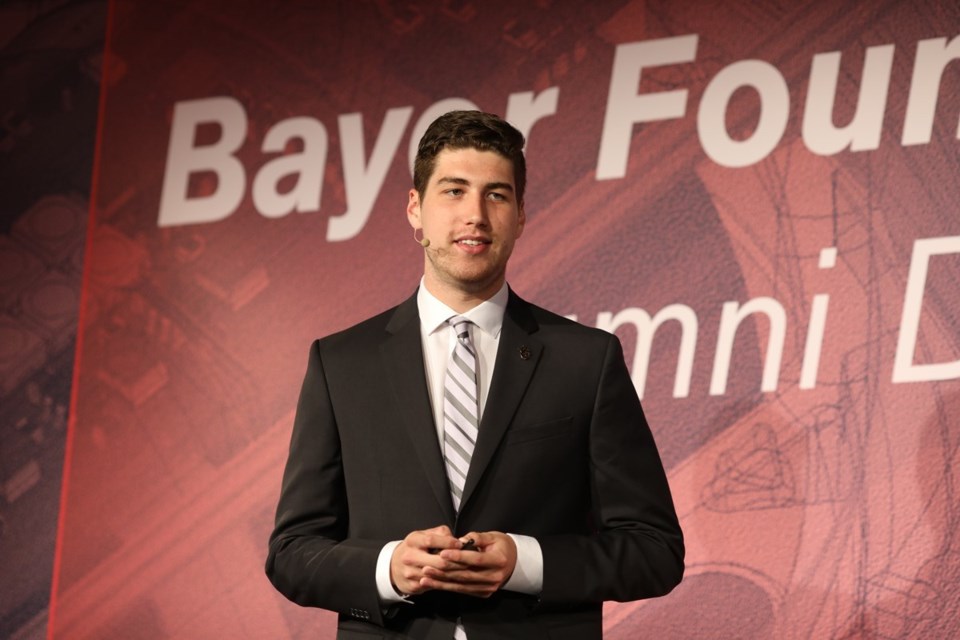Here’s another good reason to become a University of Guelph Gryphon: space travel.
People may not think of Canada’s food university as one of the Canadian institutions most closely linked to space.
But researchers in many labs on campus are highly regarded in such studies.
For example, physics researchers here have worked extensively on the Mars rover. Professor Ralf Gellert led an international group of scientists that developed the APXS (alpha particle X-ray spectrometer), Canada’s contribution to NASA’s Mars Science Laboratory rover Curiosity. It’s well known for exploring the red planet.
Human Health and Nutritional Sciences professor Leah Bent has studied why astronauts experience tingling sensations in their feet during space travel. She investigates neural connections between peripheral sensory receptors such as skin, muscle and joints, and pathways to the brain, and synapses that generate reflexes responses in muscle.
And one of the most enduring examples of the university’s connection to space belongs to environmental sciences professor Mike Dixon, and his controlled environment systems research lab.
Dixon was a pioneer in greenhouse research – among the most practical and applied controlled environments on Earth – and went on to engage in studies designed to address astronauts’ need to grow their own food for extended space missions. He’s become a world authority on food for space, and continues to blaze new frontiers in controlled environment crops.
“Food determines how far we can go from Earth and how long we can stay,” says Dixon.
Space research has advanced with the help of these labs and other university and government labs around the world. Canada has produced big-name astronauts – among them, Guelph graduate Roberta Bodnar, governor general Julie Payette, federal minister of transport Marc Garneau, “astro-troubador” Chris Hadfield and Bob Thirsk, to name a few.
Joining their ranks Monday was astronaut David Saint-Jacques of the Canadian Space Agency, who left on a mission to the International Space Station, where astronauts are working together to advance space travel. At least 200 experiments are being conducted there at any time.
One such project is closely connected to one of Dixon’s students, environmental science major Connor Kiselchuk.
Kiselchuk was introduced to space travel in his third year as a U of Guelph student, when he heard Canadian astronaut Thirsk speak on campus about Tomatosphere. It’s a program Guelph helped launch to put tomato seeds in space, then distribute them to schools where they’re grown plants and see if space travel changed their ability to germinate.
Tomatosphere has been a huge hit, engaging more than three million students across Canada since its inception in 2001.
“That piqued my interest in space,” says Kiselchuk. “I’ve never looked back.”
He approached Tomatosphere scientific director Dixon for a volunteer spot in his lab. In one year, Kiselchuk dedicated 250 hours to learning how to grow plants in controlled environments.
His enthusiasm and talent paid off quickly. In 2017, he won the Jeff Schell Fellowship from Bayer Crop Science, which he served over eight months at DLR (German Space Agency) in Bremen. There, he was part of an international team that designed, built, tested and deployed a self-sufficient greenhouse to the Neumayer-III research station in Antarctica – where it remains today, producing fresh food for the overwintering crew.
This project was called EDEN ISS and focused on developing the growing technologies that might be one day implemented into a greenhouse on another planetary body.
And then came the big prize: a four-month placement at the NASA Kennedy Space Center, as part of the on-orbit plant production team. There, he worked as what’s called a “pseudo-naut,” someone who mirrors on Earth the experiments that an astronaut would do in space.
In Kiselchuk’s case, the experiment was working on fertilizer requirements and optimum light requirements for growing plants in space.
Last month was a pinnacle for him, when his plants were germinated on the international space station’s orbital greenhouse. There, astronaut Serena Aunon-Chancellor of the US and German astronaut Alexander Gerst are growing Dragoon lettuce and Red Russian Kale, chosen specifically for their respective concentration in B vitamins and other compounds which have been known to be lacking in astronauts’ current pre-packaged diet.
Half of the crop (three plants) will be eaten, while the other half is sent back to earth for microbiological analysis as well as nutritional analysis.
This experiment, termed VEG-03, was the latest in the relatively short history of plant biology in space. Kiselchuk planted the seeds under sterile conditions in what’s called a plant pillow, a textbook-shaped Kevlar bag filled with growth substrate. A dozen pillows were loaded into a capsule for SpaceX’s 16th commercial resupply mission, propelled into space by a Falcon 9 rocket from Kennedy.
“In addition to understanding what to grow in space, we continue to look at how we can grow more reliably and sustainably so that future missions can be more self sustaining,” he says. “Space is inhospitable. Resources are scarce and pollution is not tolerated.”
And how do astronauts like being farmers?
“The feedback I get is that growing plants on the space station is one of their favourite things to do,” says Kiselchuk, who hopes to enter a Master’s program in 2019. “Astronauts jockey for the job to grow plants…it helps their mood seeing something green, caring for another organism, it’s like horticultural therapy.”
